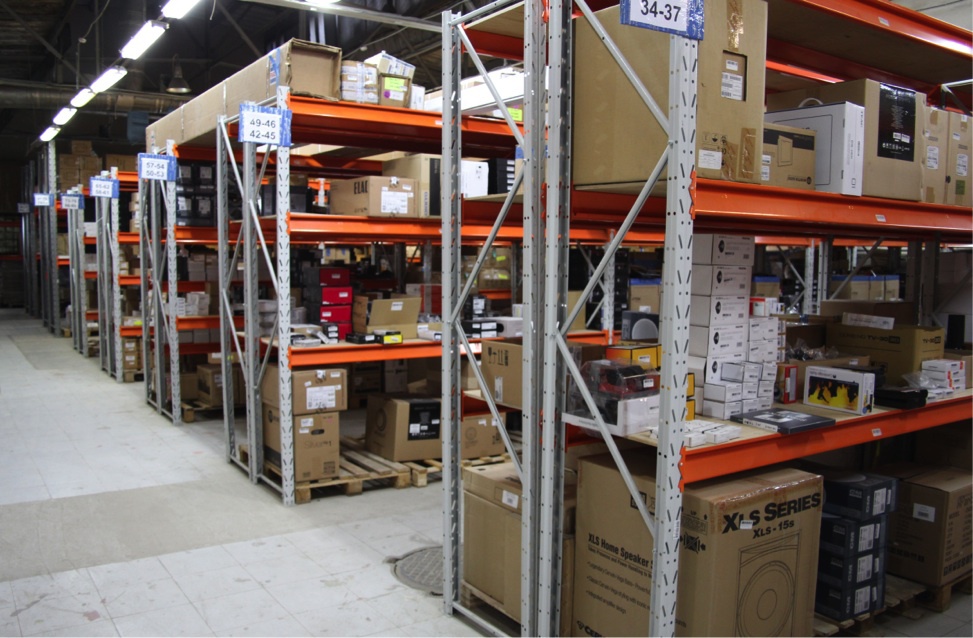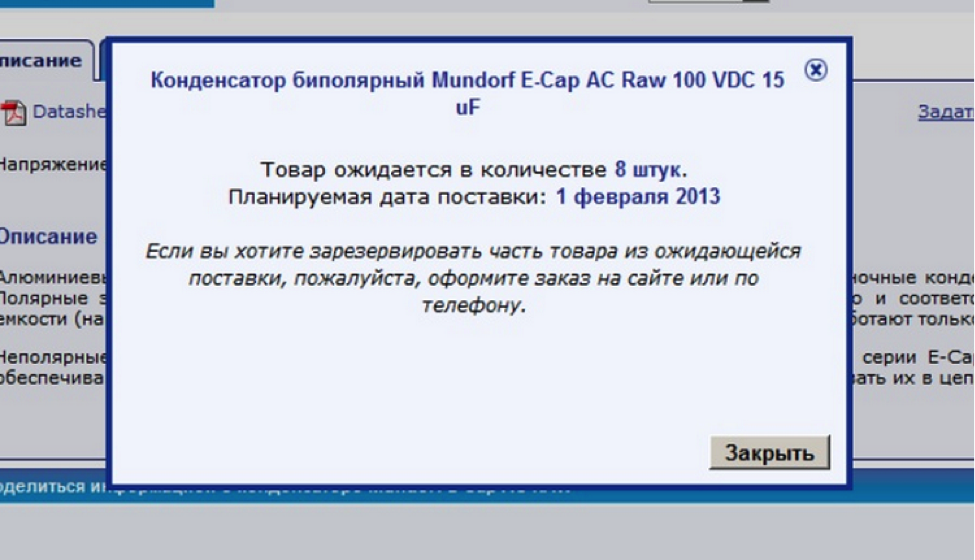Automation of warehouse processes of an online store: the experience of Audiomania - Part 2

[In the first part of the story, we wrote about how the automation of warehouse processes in Audiomania began: we described the problems that we encountered before automation, the tasks that we set for ourselves, and how we (by trial and error) were able to solve issues of equipping a storekeeper and creating their own warehouse management system.
About the know-how of our system, the logic of the organization of storage facilities, the results of the project, as well as about what advantages our end customers received from the reorganization, read below.]
Solution (continued)
Logic of organizing a warehouse
After writing software and solving the problem of equipping employees, it's time to look at the warehouse from the point of view of the logic of its organization. At the moment in the warehouse of Audiomania you can find several types of storage tanks.
First of all - boxes for small things. Next come the trays for larger goods (boxes and trays differ only in size - the boxes are smaller, the trays are larger). We used both boxes and trays before - now the principle by which goods fall into these containers has changed. Previously, product names were pasted on them (sometimes separated by commas), now trays and boxes received labels with bar codes. At the same time, the use of boxes and trays began to be strictly regulated - in each of them now only one article can be stored. To achieve this, I had to at the same time check the labels and contents of the containers: in parallel, discrepancies were identified and eliminated (some goods should not have been in a specific container or something, on the contrary, was missing).
One of our know-how that we applied in the process of reorganizing the storage of goods in boxes was that after labeling the label on the box, the goods were not transferred, but simply “placed” according to the system. Thanks to this, we were able to avoid sticking labels on ourselves (small in size) goods that we store in boxes - unlike our system, not a single ready-made warehouse management solution known to us can work with goods without an individual label. It is worth noting that the use of individual bags for goods (it is used to solve this problem) is unprofitable if, for example, we are talking about inexpensive radio components.
For sections of the warehouse wall to which the boxes are attached, we introduced horizontal and vertical numbering, which speeds up the search for the place where the box is located (currently the wall with drawers continues to be completed as needed). The logic of storing the trays in the warehouse is as follows: they are placed on the shelves and are characterized by a combination of parameters: the number of the rack + the number of the "place" on the rack (the drawers have one rack for all).

Warehouse wall reserved for boxes.
The third type of storage tanks is shelves on racks. On any shelf can be any number of various products. Moreover, each shelf is one “place”, and the location of the goods is tied to it. As a result, the build process looks like this:
- The employee scans the barcode from the wall and receives a new task on the smartphone.
- The system shows the number of the place, name, quantity of the product and, if necessary, a photograph (the product’s photo is very useful if you are talking about vinyl records - it’s much easier and faster to find the one you need from the cover photo than by artist name and album name) .
- First, the place is scanned, then the goods. Scanning a place is necessary because often the same article can be in different places (including neighboring ones) - it is important to make sure not only that this is the right product, but also that it is taken from the right place. As for the scanning of goods, in the case of goods from boxes and trays, it is not the goods themselves that are scanned (since they are not provided with individual stickers), but a bar code glued to a box or tray (since there is always only one article in a box / tray) .

This is what the contents of one of the boxes look like.
With such an approach, it is simply impossible to take something wrong or wrong. This storage system literally allows warehouse workers not to “look for goods”, but to “collect an order”. It is interesting that employees began to call this process “assembly” just after the reorganization of the warehouse - before that they used the word “search”, which was quite true. After the introduction of these innovations, the average time before the start of the assembly of the order (from the moment of “taking” the application - its receipt on the smartphone of the warehouse employee - until the first product is found) is from 30 seconds to 1 minute (the assembly time itself varies greatly depending on the dimensions of the goods and quantity units of goods in the order). At the same time, the employee spends most of this time to get to the right place.
After the right product is found, it (if sent outside of Moscow, for example) must be packaged. For this (based on the delivery parameters of the goods), the system generates the necessary set of documents and an identification sticker on the box. A warehouse employee packs the goods in a box, sticks a sticker with a barcode, scans it, after which the system tells him where to put the packed goods. Further dispatch of the goods to the transport company is carried out as usual assembly - only instead of specific goods this time are the boxes with orders. If we have established information exchange with the delivery service, then at the stage of labeling the box, we generate and print the barcode of the transport company. As a result, we optimize not only our internal processes, but also the receipt and processing of parcels from transporters,

Bulky goods are placed on shelves.
Assembling and sending warehouse tasks are not limited. Acceptance of goods is an equally important part of his work. In order to avoid overlays, discrepancies and confusion during reception, we have a so-called “unbroken zone” where we check the conformity of the goods of the supplier’s waybill, labeling and further distribution to storage locations. Moreover, now a “responsible” employee in the undeveloped area is required only at the stage of labeling (here you must carefully check the conformity of the product with the label attached). The rest of the warehouse workers are doing work that is very difficult to make a mistake.
It is important to note that each action of each employee is recorded on video. As a result, we get a lot of tools for forming the KPI of warehouse workers and can study the bottlenecks of the entire system: monitor the processes that occupy employees the most time and work on them. For example, if we see that one of the workers takes an operation longer than the others, we can conduct additional training and increase its productivity.
View from the user
For the convenience of users, the website of the online store Audiomania shows not only the status of the availability of goods, but also specific stores where it is.

Information on the availability of goods through the eyes of the user
If we do not have the goods at the moment, but there is data from the supplier on the delivery time, the goods are assigned the status “Expected”, and you can see exactly when it should arrive at the warehouse and in what quantity. Such goods can be paid in advance.

If there is no product at the moment, you can specify exactly when it will arrive to us
results
The entire project of optimizing the operation of the warehouse took us three months, and during this time we managed to achieve a significant increase in the speed and quality of operations performed at the warehouse. In particular:
- It was possible to minimize paper workflow. Of course, from the need to print documents, invoices, etc. impossible to leave, but automation can significantly reduce the number of various pieces of paper. For internal work of the warehouse, paper documents are not required at all now.
- Re-grafting and other problems now occur only in 0.1% of cases. It is impossible to bring this number to absolutely zero due to the human factor: no one is immune from mistakes, but we have very few of them and they are very quickly fixed.
- Effective and fast training of new employees. Previously, training a new warehouse employee could take considerable time, and people did not start working at full strength right away. Now all the training takes from half an hour to 1 hour, after which the employee is fully ready to effectively and efficiently carry out their tasks.
- Increased employee efficiency through a system of priorities. It is no longer necessary to collect and pack orders that will be sent only tomorrow, as a result - in parallel with an increase in efficiency - the load on employees is more effectively distributed.
- Reduced assembly time. Now in Audiomania, orders are collected 10 times faster than before the introduction of automation.
- The record of order processing time is 4 minutes 59 seconds. This is the minimum time from the moment the customer clicks the "place order" button until the package is ready to be sent.
As you can see, the result was worth the effort. Automation of warehouse processes has enabled us to more effectively help our customers. We hope that our experience was interesting for you. Thank you and don’t forget to subscribe to our blog !
